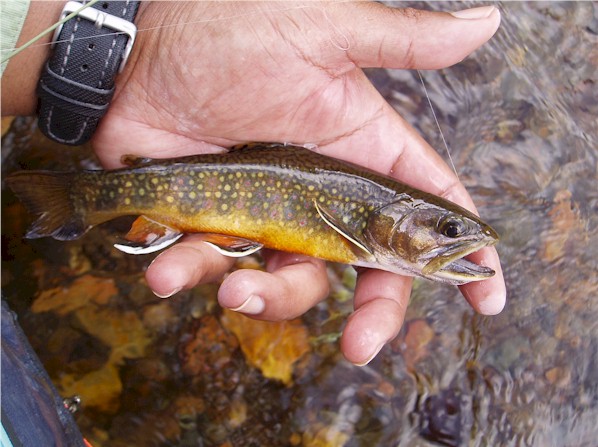|
|
|
|
|
|
|
The very first thing you are bound to hear about Brook Trout is that they are not "trout" at all but are "Char". Well, what does that mean? It basically means they belong to a different genus than other "trout" in the family Salmonidae. From a layman's standpoint it simply means that they do not have black spots on their body, have one set of teeth (Rainbow Trout and Brown Trout have two sets) and have smaller scales. From a fisherman's standpoint it means absolutely nothing. Brook Trout, often called the "Eastern" Brook Trout, get a bad rap. Native to the Northeastern United States and far northern parts of the Mid West and Canada, the Brook Trout has been planted far and wide in the high country, where it has prospered. Unlike Rainbow and Golden Trout (genus Oncorhynchus), the Brook Trout can spawn just about anywhere and successfully reproduce where other trout species can not. As a result, Brook Trout streams and lakes can become over populated and the fish stunted. It is not unusual to find a Brook Trout with an abnormally large head in proportion to it's body, the sure sign of a stunted fish and a lake or creek that could do with some harvesting or thinning out of the population. Very often anglers who are dearth to catch and keep other species of trout in the high country, will search out the brook trout for this very purpose. In truth, Brook Trout are among the most beautiful of all trout and simply a product of their environment. Always eager to take a fly, many people have pegged the Brook Trout as easy pickings and that is not always true. The very fact that Brook Trout have a tendency to overpopulate streams and rivers mean's two things- greater competition for food and a larger population of fish to cast to. Both facts would result in a greater percentage of hook ups than with other trout and thus make the Brook Trout the perfect target species for beginners and children. In the proper setting though, Brook Trout can be just as finicky and difficult to catch as a spring creek Brown Trout. Many people have trouble identifying the brook trout and often confuse it with it's European cousin the Brown Trout. Differentiating the Brook Trout from the Brown Trout is rather easy, if it has black spots, its not a Brook Trout. Differentiating a Brook Trout from other types of Char, such as the Bull Trout or Dolly Varden is not as easy. Most high country anglers will never come across the latter fish. The Brook Trout can be identified by wavy yellow markings on it's back and dorsal fin with small red spots within blue spots and slightly larger yellow spots scattered through it's body. In the water, Brook Trout may be confused with Golden Trout due to their bright orange belly which can often be seen glowing beneath the water.
|
|
|
 |
